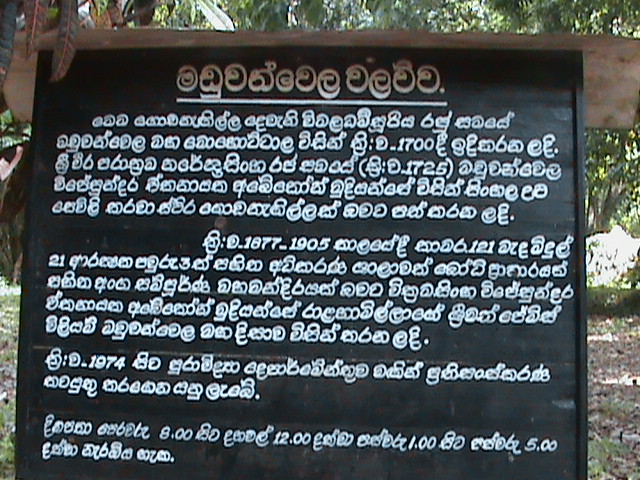Maduwanwela Manor House
Situated 26 kilometres from Embilipitiya, the ancient
mansion is reached on the Kolonna road. The Maduwanwela Walauwa was originally
built during the early 1700s when Maduwanwela Mohottala was gifted land by the
king of Kandy
for his valour in the defeat of the Dutch Garrison at Katuwana. The family was
granted more land later till they owned over 80,000 acres in the area. The last
nobleman to carry the Maduwanwela name was Sir James Maduwanwela who was
commonly known as Maduwanwela Maha Dissawe. He was a colourful character,
notorious for his dislike for the British rulers. A good indication of what he
thought of the colonial masters is his selection of floor tiles with the head
of Queen |  |
The Dissawe who was a man of small stature, seemed
to have had a complex about his height since all the doors and entrances to the
mansion were made so that any tall person would have to bow very low before
entering. The stone archway at the entrance of the Walauwa too has been
designed so that a person on horse back needed to demount.
Currently the mansion is under the protection of the Archaeology Department.
Though the Walauwa is promoted as a tourist destination with many billboards
directing visitors to it, for reasons best known to the Department, tourists
are not allowed to take photographs. Irrespective of such bizarre restrictions,
the mansion still remains a fascinating edifice of magnificent architecture and
is well worth a visit. It has over 120 rooms designed for various purposes and
has 21 courtyards (Meda Midul) as well. The numerous stories of love, courage
and scandal associated with the noble occupants of the mansion adds to the
charm of the place which takes the visitor back to an era long gone.
 | On the way, there is the small town of Panamure,
rekindling memories for some who still remember the saga of the Panamure Ath
Raja, the magnificent tusker who became a legend due to its stubborn resistance
to be tamed after being captured along with its herd. The controversy which
resulted due to the killing of this king of beasts led to a public uproar and
the eventual banning of kraals in the 1950s.
|
Though an Archaeology Department sign marks the spot where the captured elephants were tethered, little remains of the place except for few stone pillars on which the elephants were tied.




